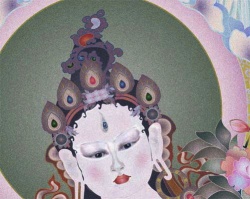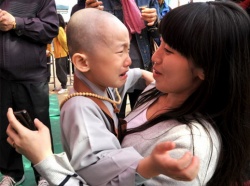Difference between revisions of "Ongi-kuden"
m (Text replacement - "{{Wiki|related}}" to "related") |
m (Text replacement - "]]]" to "]])") |
||
| Line 1: | Line 1: | ||
{{DisplayImages|131|1072|2271|1859|2444|3599}} | {{DisplayImages|131|1072|2271|1859|2444|3599}} | ||
<poem> | <poem> | ||
| − | The title [[Ongi kuden]] means The [[Record of the Orally Transmitted Teachings]] [of [[Nichiren]] | + | The title [[Ongi kuden]] means The [[Record of the Orally Transmitted Teachings]] [of [[Nichiren]]). The text is found in the [[Nichiren Daishōnin]] gosho zenshū, or The Complete Works of [[Nichiren Daishonin]], published by the [[Soka Gakkai]] ({{Wiki|Tokyo}}, 1952). |
In his later years, when [[Nichiren]] was living at Mount [[Minobu]] in the province of [[Kai]] (in present-day Yamanashi Prefecture), he wrote various [[doctrinal]] works and labored strenuously at other [[activities]] designed to encourage his followers and train [[disciples]] to carry on his teachings. | In his later years, when [[Nichiren]] was living at Mount [[Minobu]] in the province of [[Kai]] (in present-day Yamanashi Prefecture), he wrote various [[doctrinal]] works and labored strenuously at other [[activities]] designed to encourage his followers and train [[disciples]] to carry on his teachings. | ||
Latest revision as of 20:09, 4 April 2016
The title Ongi kuden means The Record of the Orally Transmitted Teachings [of Nichiren). The text is found in the Nichiren Daishōnin gosho zenshū, or The Complete Works of Nichiren Daishonin, published by the Soka Gakkai (Tokyo, 1952).
In his later years, when Nichiren was living at Mount Minobu in the province of Kai (in present-day Yamanashi Prefecture), he wrote various doctrinal works and labored strenuously at other activities designed to encourage his followers and train disciples to carry on his teachings.
In response to a request from his disciples, from time to time he delivered lectures on the Lotus Sutra. In one of his letters he writes to a correspondent, “And then in time you arrived at this remote hollow and saw a lone hermitage where the sound of Lotus Sutra recitation echoed to the blue sky and the words expounding the single vehicle were heard among the mountains.”1
The Ongi kuden represents the notes on these lectures that were recorded and put into order by Nichiren’s close disciple and successor, Nikkō, and that, with Nichiren’s permission, were handed down to posterity. After Nichiren’s death, Nikkō continued to gather together Nichiren’s various writings and make copies of them, thus contributing greatly to the preservation of his teacher’s doctrines.
It would appear that Nichiren several times lectured on the Lotus Sutra during his years at Mount Minobu. A series of lecture notes on the Lotus Sutra was also compiled by Nikō, who was later designated as one of the six senior priests. It is known by the title Okō kikigaki, or The Recorded Lectures, and is quite different in content from the Ongi kuden.
Nikō’s Recorded Lectures consists only of disconnected notes on certain particularly important passages of the sutra. Nikkō’s Ongi kuden, on the other hand, begins with an explanation of the term Nam-myoho-renge-kyo and then goes on to a discussion of important passages in all of the twenty-eight chapters of the Lotus Sutra, and in the two short sutras that serve as its introduction and conclusion, the Immeasurable Meanings Sutra and the Universal Worthy Sutra. Nichiren’s explications of these key passages, sometimes taking the commentaries of T’ien-t’ai and Miao-lo as a starting point, present his own doctrinal interpretations in clear and simple language.
The differences that exist between the lecture notes of these two men, Nikō and Nikkō, no doubt reflect major differences in their respective understanding of Nichiren’s teachings.
The oldest version of the Ongi kuden for which there are historical references seems to have been copied on the eighth day of the fifth month of the eighth year of Tembun (1539). It belonged to Nichikyō, a priest of the Happon, or Eight Chapters, branch of the Nichiren school. Though it does not exist today, records available identify it as the oldest known copy.
The Content of the Ongi kuden
The Ongi kuden, as noted above, begins with a discussion of the term Nam-myoho-renge-kyo and then comments on a total of 231 key passages from the twenty-eight chapters of the Lotus Sutra, the Immeasurable Meanings Sutra, and the Universal Worthy Sutra. This is followed by a section that comments on one particularly significant passage in each of the chapters of the Lotus Sutra, and by a concluding section entitled “All the Twenty-eight Chapters of the Lotus Sutra Are Nam-myoho-renge-kyo.”
This arrangement of the material in the Ongi kuden is closely related to the thought of the work as a whole, reflecting Nichiren’s conviction that Nam-myoho-renge-kyo represents the heart or core of his teachings and of the Lotus Sutra, and that the twenty-eight chapters of the Lotus Sutra constitute explications from various angles of how it functions. As the Ongi kuden itself states on page 221, “Now when Nichiren and his followers propagate Nam-myoho-renge-kyo, this is the principle of essence or heart. The twenty-eight chapters of the Lotus Sutra are the principle of function.”
The opening passage on Nam-myoho-renge-kyo describes in simple terms the deep philosophical significance of this concept. In the comments on key passages in the Lotus Sutra, Nichiren at times quotes from commentaries by earlier Buddhist scholars such as T’ien-t’ai or Miao-lo. Then, basing himself on the doctrine of three thousand realms in a single moment of life, he makes clear how ordinary persons in the evil age that is the Latter Day of the Law, by carrying out the practice appropriate to that age and putting faith in and upholding the truth of Nam-myoho-renge-kyo, can attain Buddhahood. Interpreting the sutra freely and in a manner that accords with his own unique point of view, he proceeds to bring to light what he regards as the ultimate significance of the work.
The earlier commentaries by T’ien-t’ai and Miao-lo had sought to uncover the meanings that were implicit in the words of the Lotus Sutra. In the passages of the Ongi kuden that deal with Nichiren’s own interpretation of the text, however, he seeks to reveal the underlying intent or purpose of the work, reinterpreting the key passages of the sutra in such a way that they will be meaningful to his contemporaries, those persons who are practicing Buddhism in the Latter Day of the Law. This is the focus of his attention. By at times going along with the earlier commentaries of T’ien-t’ai and others, and at other times speaking in a manner that departs from their views, he makes clear how his own interpretations differ from those of his predecessors and thus deepens the reader’s understanding of his doctrines.
In most of the comments that Nichiren makes on the Lotus Sutra, he addresses himself to the particular passage of the sutra that he has singled out for discussion. In his treatment of the “Life Span” chapter, however, which occupies a place of such great importance in Nichiren’s doctrines as a whole, he departs from the exact wording of the text to comment on more general topics such as the Jigage, or verse section with which the chapter closes, or on the term kuon, or “time without beginning.”
Again, in dealing with “The Bodhisattva Never Disparaging” chapter, one of particular significance in terms of Buddhist practice, he outlines fourteen different ways in which one may view the bodhisattva’s practice of bowing in obeisance to all persons. Thus, he relates it to the words “open, show, awaken, and cause them to enter” of the “Expedient Means” chapter, or the words “At all times I think to myself” or “Originally I practiced the bodhisattva way” of the “Life Span” chapter, and he shows how it relates to such fundamental Buddhist concepts as birth, aging, sickness, and death, the Dharma nature, ignorance; and to such practices as pity and compassion.
In the section that follows, Nichiren begins by quoting what he regards as an essential passage from each of the twenty-eight chapters of the Lotus Sutra. To the left and right of each passage he then appends brief glosses that deal with the doctrinal aspect or meaning of the passage and the deeper or meditative aspect, or what has been referred to in Mr. Ikeda’s Foreword as the interpretation based on the “observation of the mind.” In a brief paragraph marked “Summary,” Nichiren then proceeds to outline what he sees as the true meaning of the passage in terms of his own philosophy.
The concluding section is entitled “All the Twenty-eight Chapters of the Lotus Sutra Are Nam-myoho-renge-kyo.” This sums up the doctrinal significance of each of the twenty-eight chapters of the Lotus Sutra, and makes clear how all these meanings represent different aspects of the single fundamental truth of Nam-myoho-renge-kyo.
Thus we see that the Ongi kuden is a work that reveals the various angles from which Nichiren viewed the concept of Nam-myoho-renge-kyo, the heart of his enlightenment and subject of all his teachings.
From his comments on key passages in the Lotus Sutra, it is clear that Nichiren saw all of these as ultimately related to the concept of Nam-myoho-renge-kyo. And his own explanations are intended to bring out the true meaning of this concept of Nam-myoho-renge-kyo as it is hidden in the various passages of the sutra. We may thus view his teachings as a demonstration of how the countless ideas or doctrines expounded in the text of the sutra, which to modern readers may seem so manifold in their conclusions, derive in the end from this one underlying truth or Law of Nam-myoho-renge-kyo.
The Thought of the Ongi kuden
Readers who are already familiar with Nichiren’s teachings and his manner of expressing them should have little difficulty in understanding the Ongi kuden. But for those who lack such background knowledge, a word may be said here about the thought and manner of presentation that characterize the text.
Mahayana Buddhism speaks often of two types or levels of truth, the worldly or relative truth and the supreme or absolute truth. The two types of truth are in fact referred to in the Ongi kuden itself, on page 208.
In his comments on the Lotus Sutra, Nichiren often refers to the persons and events described in the sutra in terms of their meaning on the level of relative truth, that is, as they apply to the world of ancient India depicted in the sutra. But he then frequently moves to a higher level of truth, reinterpreting the same event or passage in terms of what he sees as their absolute meaning or intention, namely, how they apply to other places and ages, or to all ages and places, to all humankind.
An excellent example of this is found in his comments on the “Simile and Parable” chapter on page 209, where he refers to the big white ox cart described in the sutra, which carries the children to the place of practice, where they will attain enlightenment. But then he abruptly leaps to a higher level of truth or meaning, declaring, “This passage describes how one becomes aware of the Buddha vehicle within oneself and enters the palace of oneself. Chanting Nam-myoho-renge-kyo is what is meant by entering the palace of oneself.”
His comments on the literal meaning of the sutra represent the doctrinal meaning or aspect of the text. Those that relate to a higher or symbolic meaning represent the meditative aspect, or what is referred to as “observation of the mind,” that is, the truth underlying the passage as it is perceived through enlightenment.
It is these latter interpretations that represent Nichiren’s true teachings, the means by which, as Mr. Ikeda notes in his Foreword, Nichiren “infused new life into the Lotus Sutra.”
The level of worldly or relative truth is characterized by dualistic thinking; ideas are viewed as contrasting pairs, each term dependent upon its opposite for its existence, e.g., good/bad, happiness/unhappiness, ignorance/enlightenment. On the level of supreme truth, however, dualistic thinking is transcended, and opposites, because of their lack of independent and distinctive nature, merge into a single entity. Thus Nichiren, speaking on this level of truth, can say, as he does so often, that earthly desires are none other than enlightenment, and the sufferings of birth and death are none other than nirvana. In terms of everyday logic, or the realm of worldly truth, such statements seem arbitrary or even fantastic. Understood from the level of higher truth, however, they represent the core of Nichiren’s teaching, the fact that all persons are in fact Buddhas.





